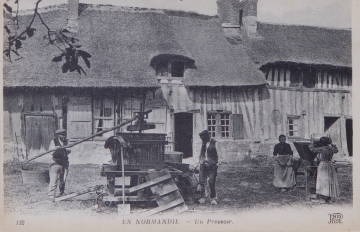History of Calvados

From cider to brandy
Ciders, or in Latin sicera -- meaning "intoxicating drink" -- have been around since ancient times. Consumed by the Norman Vikings who drank it with beer in the 10th century, cider because a refined product in the 15th century when it began to be appreciated by the nobles and the clergy. It was then that rumours begin to be heard about what was know as aqua vitae in Latin, or eau-de-vie in French, i.e. colourless brandies distilled from fruit, whose elaboration was associated with apothecaries and monasteries. However, the first documented distillation in Normandy dates back to the 16th century: on 28th March 1553, a gentleman from the Cotentin region by the name of Gilles de Gouberville writes in his journal about distilling cider to obtain an "eau-de-vie de bouche", or a "potable spirit". He writes about the cultivation of cider apple trees having recently been supplemented by the arrival of new varieties from the Basque Country. Shortly thereafter, in 1606n the distillers of Normandy's cider brandy established themselves as a corporation. In the 17th century, traditional cider farms were developed: the majority of the farms produced their own cider and calvados. Pot stills begin surfacing throughout the countryside to carry the distillations.
The development of calvados
With the French Revolution, the Calvados region was created, but cider brandy, mainly a farmers' drink, was by then already called "calvados" by the people. After the French Revolution, trade was liberalised and expanded. Aided by the communication routes, brandy made in the production area closest to Paris benefited the most. "Calvados" became popular in Paris, and it would soon refer to all cider brandies from Normandy. In the 19th century, production increased with industrial distillation. The working classes appreciate in particular the "café-calva" (calvados coffee) and "la goutte" (popular name for this eau-de-vie). Calvados had its golden age at the end of the 19th century, when a phylloxera epidemic devastated the vineyards. At the beginning of the 20th century, the calvados production was of great economic importance in Normandy. Quality was improved and controlled, thanks in particular to centrifugation and filtration.


The Calvados AOC
In 1942, a decree recognised Calvados Pays d'Auge as an Appellation d'Origine Contrôlée (Controlled Designation of Origin) and protected it from war requisitions. Calvados produced in other areas under the title "Appellation d'Origine Réglementée Calvados" were promoted to Appellation d'Origine Contrôlée (Calvados AOC) on 11 September 1984 by decree and Calvados Domfrontais obtained official recognition on 31 December 1997. Since then, the calvados family has been divided into three distinct Appellation Areas.
Want to visit our distillery ?
Whether you want to visit by yourself or with friends and family, we would be delighted to welcome you and offer you a guided tour of our Distillery. You will discover our manufacturing workshops and have an opportunity to taste our products. We look forward to seeing you!
Visit the distillery